Once again, the Bank Of Canada has left the benchmark interest rate unchanged at 1.75%, blaming “escalating trade conflicts” that they find are taking a toll on Canada’s economy. The last rate change was in October 2018, which was the fifth time since the summer of 2017 that the BoC had decided to raise the rate.
The BoC also noted that the Canada’s exports are continuing to grow, the housing market is showing signs of a rebound, and that wages are also picking up. All factors that they believe show a strengthening economy, however are keeping a close eye on “global developments and their impact on Canadian growth and inflation”, such as the trade conflict between United States and China.
What does this mean? The BoC’s rate directly affects the rate that you will get from a retail bank for lending (mortgages and lines of credits) and savings products. When the rate is low, it means that it is cheaper to borrow money, but not as lucrative to save.
The BoC has eight fixed dates each year on which it announces whether or not it will change the policy interest rate. The announcement dates are January 9th, March 6th, April 24th, May 29, July 10, September 4th, October 30th, and December 4th.

















